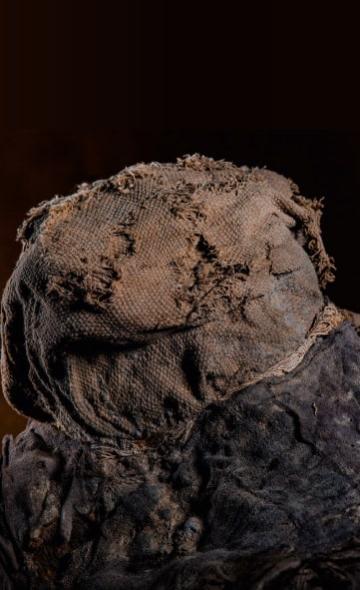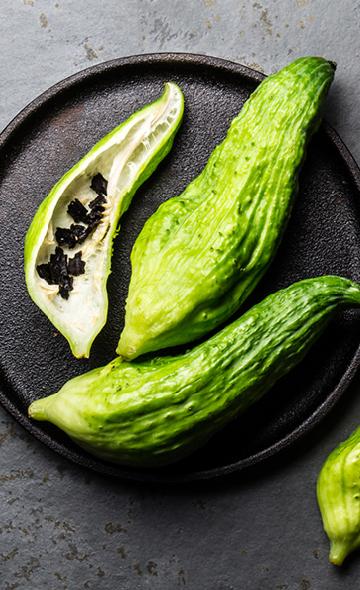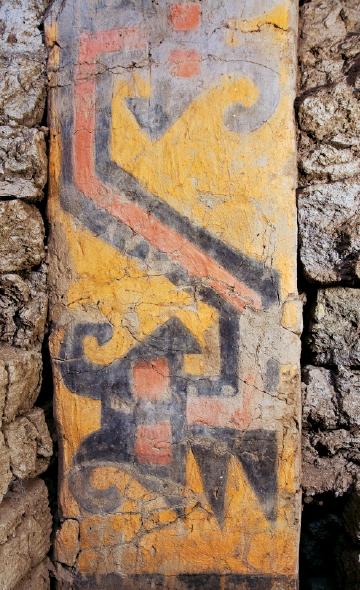- Visitors
- Researchers
- Students
- Community
- Information for the tourist
- Hours and fees
- How to get?
- Visitor Regulations
- Virtual tours
- Classic route
- Mystical route
- Specialized route
- Site museum
- Know the town
- Cultural Spaces
- Cao Museum
- Huaca Cao Viejo
- Huaca Prieta
- Huaca Cortada
- Ceremonial Well
- Walls
- Play at home
- Puzzle
- Trivia
- Memorize
- Crosswords
- Alphabet soup
- Crafts
- Pac-Man Moche
- Workshops and Inventory
- Micro-workshops
- Collections inventory
- News
- Students
- What are the types of Lambayeque funerary bundles in El Brujo?
News
CategoriesSelect the category you want to see:
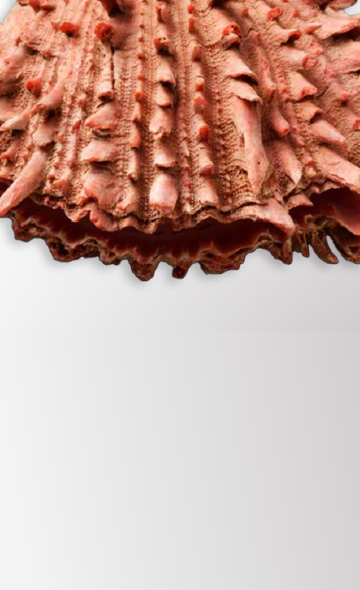
The Use of Spondylus Shells in Moche Ceremonial Contexts: Why Were They Symbols of Status and Wealth? ...
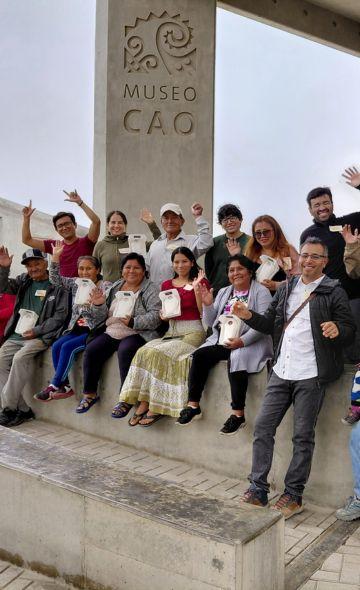
El Brujo Celebrated International Museum Day with Its Community: A Day of Encounter and Cultural Co-Creation ...
To receive new news.
Por: Complejo arqueológico El Brujo
The cultural heritage is an invaluable reflection of our history and culture. In particular, the archaeological pieces, when recovered, begin to undergo physical and chemical alterations that accelerate their deterioration. For this reason, it is crucial to provide them with the necessary care and interventions. In this article we will learn about the collection of funerary bundles of the Lambayeque culture of the El Brujo archaeological complex, to explore their origin, development and some specific characteristics about their current state.
Understanding how to manage and conserve these collections is essential for the development of responsible research and the implementation of coherent conservation strategies.
Secrets of the Past: Important Revelations in Lambayeque Funerary Contexts
The analysis of human remains in funerary contexts, especially in the Lambayeque region, has revealed fascinating information about the customs and daily life of the ancient populations that inhabited this area.
The ectoscopic and osteometric observations allowed the experts to learn more about the age, sex, and possible diseases of the buried individuals.
Evidence of ancient diseases in the Lambayeque Society
For example, the analysis of human remains has identified three skeletons of adults with lesions on their vertebrae, which could suggest the presence of tuberculosis in these ancient populations. Though this finding still requires confirmation through DNA studies, as it provides us with an important clue about the health conditions of the epoch.
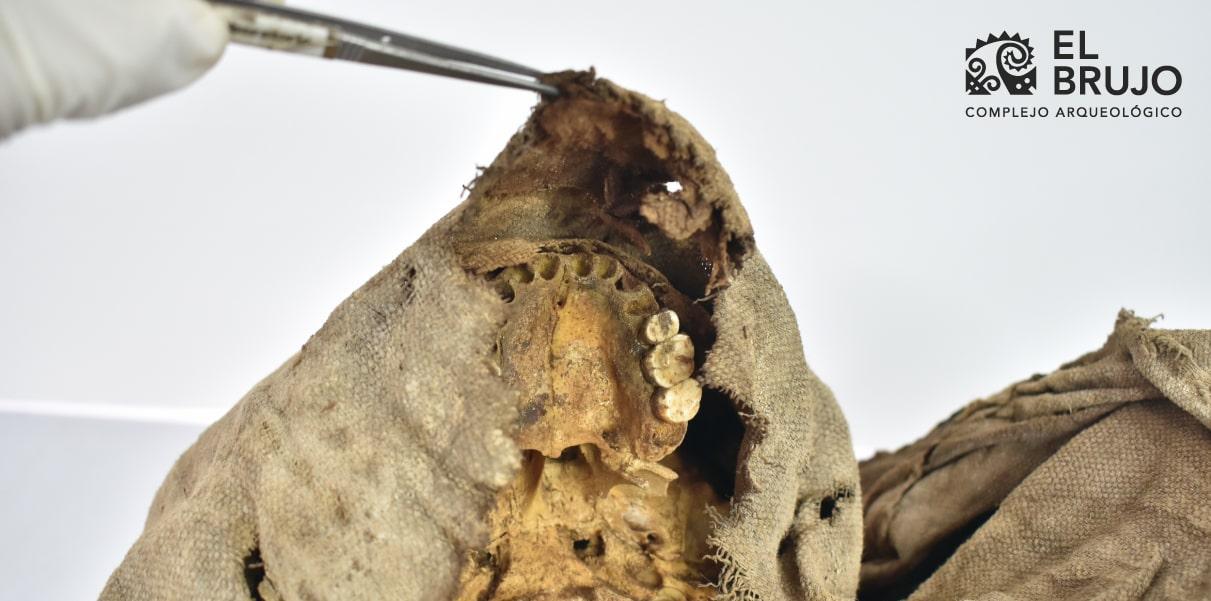
Innovations in the study of funerary bundles
One of the most significant advances in these studies has been the use of X-rays to examine funerary bundles. This technique has made it possible to observe how the bodies were placed in specific positions, such as the flexed position, and how metal pieces were found next to the remains.
These discoveries not only bring us closer to better understanding the funerary customs of the Lambayeque culture in the Chicama Valley, but also open new doors for future research that could delve deeper into the life and beliefs of these ancient societies.
Below, we present to you the types of funerary bundles that we have in our collection.
Anthropomorphic type funerary bundles – Vertical-type wrapping
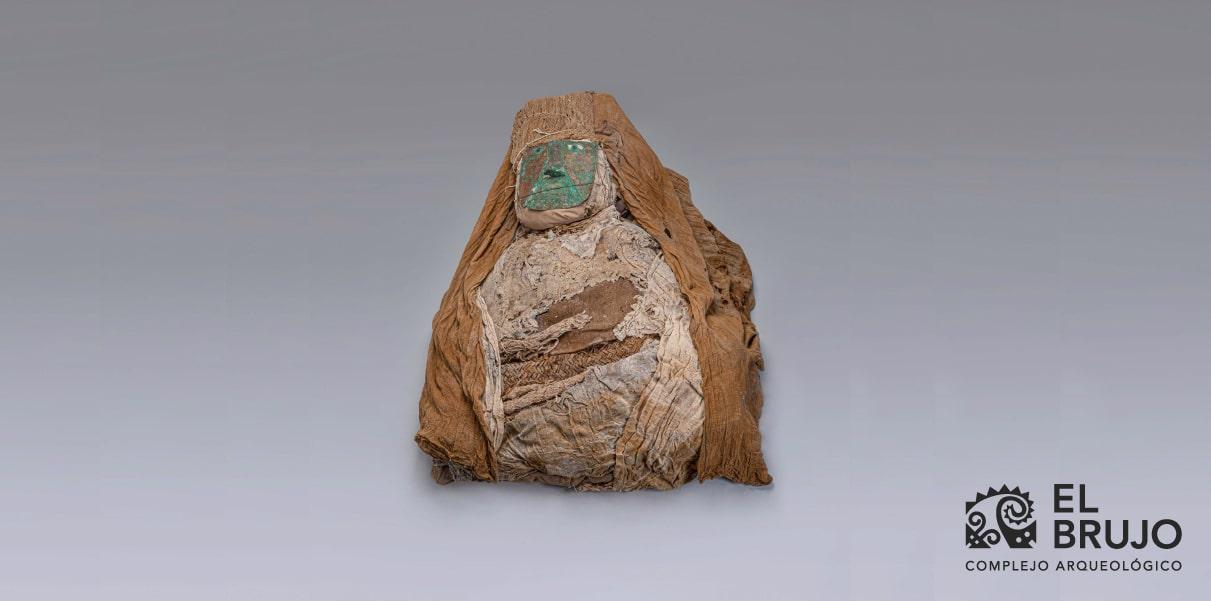
Lambayeque bundle, anthropomorphic type, vertical-type wrapping. Book Fardos Lambayeque en El Brujo, p. 145, fig. 2.61.
Funerary context: Burial 61 - 1991
Catalog code: EBBFA00000-62
Dimensions: Length: 85.2 cm | Width: 76.6 cm | Thickness: 25.2 cm | Weight: 17.715 g
Knowing more about the funerary bundle: This type of bundle contains an adult in a sitting position, wrapped in multiple layers of cotton textiles. Some of these textiles show signs of deterioration, but we can still observe details such as a turban on the head and a mask with black and red pigments. These elements give us clues about the social status of the person and the beliefs on life after death.
Anthropomorphic-type bundles – Sack-type wrapping
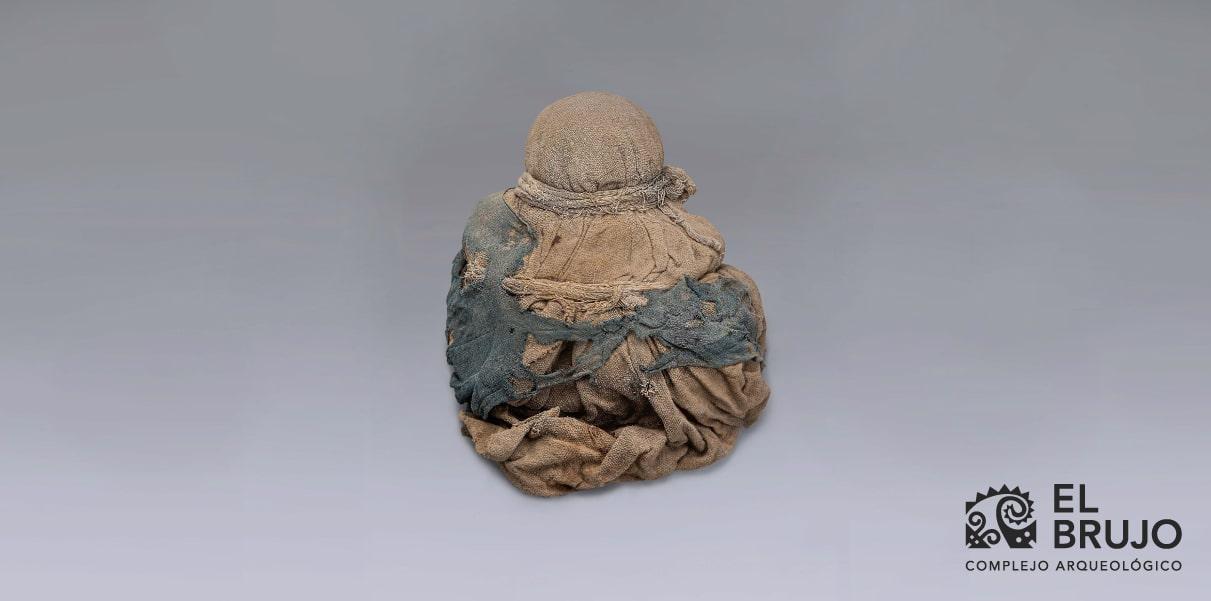
Anthropomorphic-type Lambayeque funerary bundle, sack-type wrapping. Book Fardos Lambayeque en El Brujo, p.193, fig.2.113.
Funerary context: Burial 97 – 1991
Catalog code: EBBFA00000-57
Dimensions: Length: 35 cm | Width: 31.5 cm |Thickness: 24 cm | Weight: 1500 g
Knowing more about the funeral bundle: This funeral bundle holds a subadult and wears a cotton unku (male’s tunic) dyed blue. The unku is made of two pieces of cloth joined together with seams and has openings for the head and arms. The last wrapping that covers the bundle is a cream-colored cotton cloth, sewn like a sack and secured with cotton ropes.
This wrapper was placed vertically, with the ends folded to the back. The presence of ground mollusks in the facial area, and cranial modeling are noted.
Anthropomorphic-type funerary bundles – Horizontal wrapping
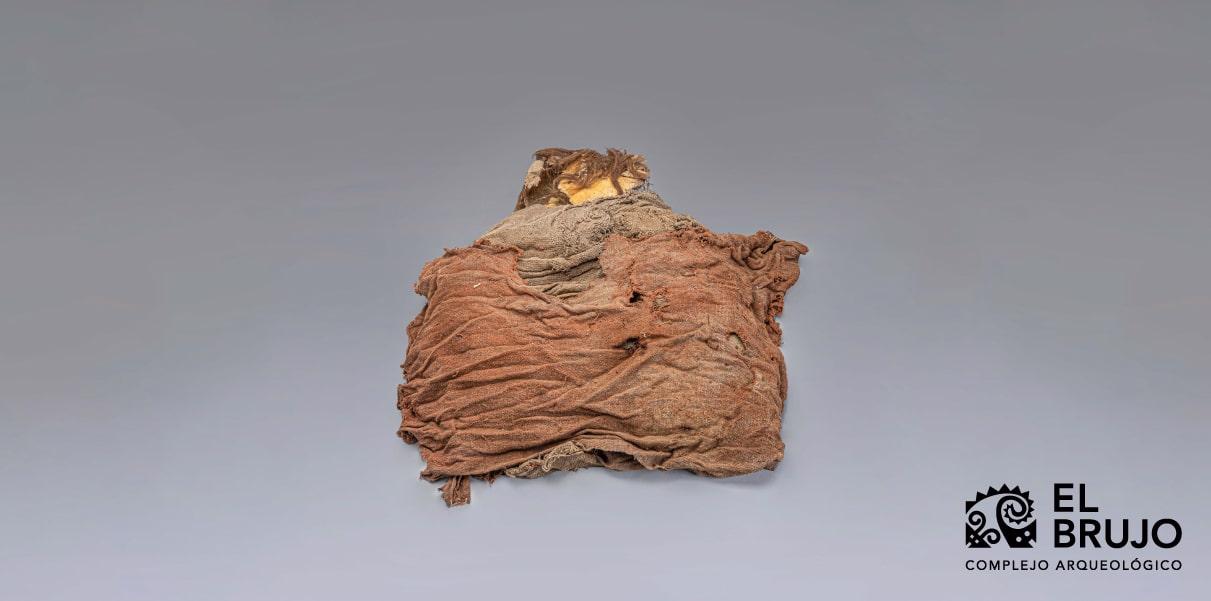
Lambayeque funerary bundle, anthropomorphic type, horizontal-type wrapping. Book: Lambayeque Funerary Bundles in El Brujo, p. 218, fig.2.140.
Funerary context: Burial 85 - 1992
Catalog code: EBBFA00000-50
Dimensions: Length: 40.5 cm | Width: 33.5 cm | Thickness: 13 cm | Weight: 2215 g
Learning more about the funerary bundle: This funeral bundle contains a subadult wearing an orange-dyed anaco (female’s tunic). Cotton ropes were used to fasten the textiles to the body.
Anthropomorphic funerary bundle – Undetermined-type wrapping
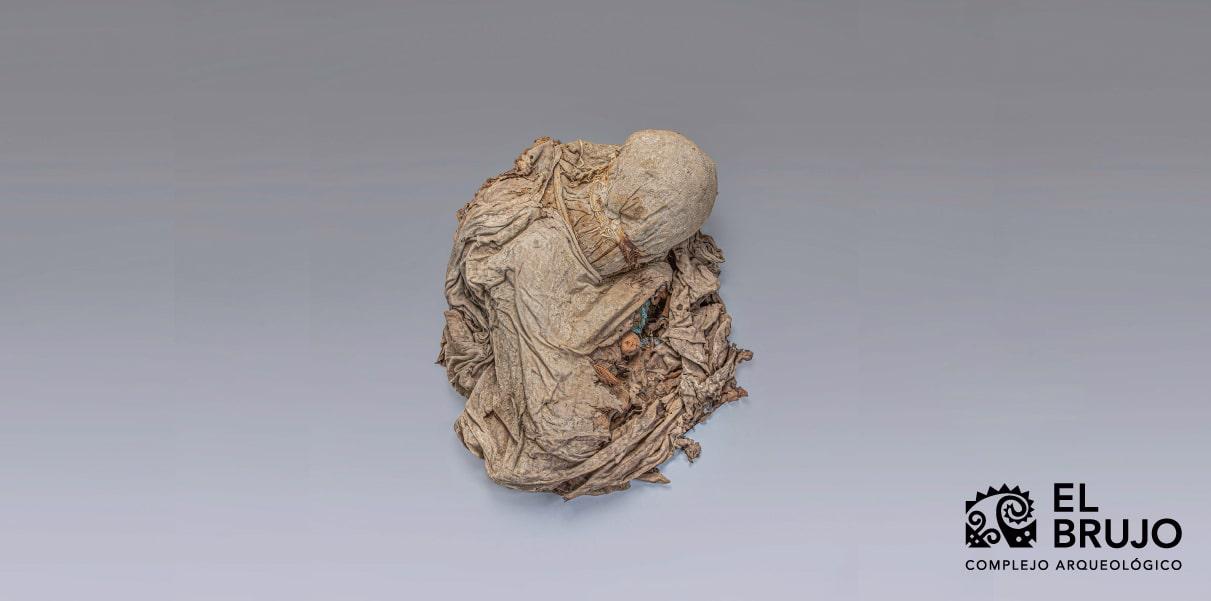
Lambayeque funerary bundle, anthropomorphic type, undetermined-type wrapping. Book Fardos Lambayeque en El Brujo, p. 258, fig.2.178.
Funerary context: Burial 58 - 1991
Catalog code: EBBFA00000-36
Dimensions: Length: 64.4 cm | Width: 50.8 cm | Thickness: 27 cm |Weight: 7020 g
Learning more about the funerary bundle: This type of bundle has an irregular shape and shows signs of use of materials such as ground mollusks or metals, which tells us about the importance of utilizing all the resources available at that epoch. Through this bundle, we can learn about the funerary practices and respect for materials that characterized the Lambayeque culture.
Visit El Brujo and live the history!
If you are interested in delving deeper into the details of these findings and exploring more about the funerary context, we invite you to discover the book Lambayeque Funerary Bundles in El Brujo, a work that seeks to make visible this rich cultural legacy, making available the catalog of the collection of funerary bundles of the CAEB, located in the lower valley of Chicama.
This work not only organizes and classifies the evidence found, but also photographically records each specimen in great detail, following appropriate scientific and ethical criteria. Through this publication, a new window is opened to explore and better understand pre-Hispanic funerary rites, as well as the social structures and mortuary practices of ancient Peru.
Don't miss the opportunity to walk through history and immerse yourself in the rich cultural heritage of our Peru. El Brujo is expecting you with open arms!
Students , outstanding news


